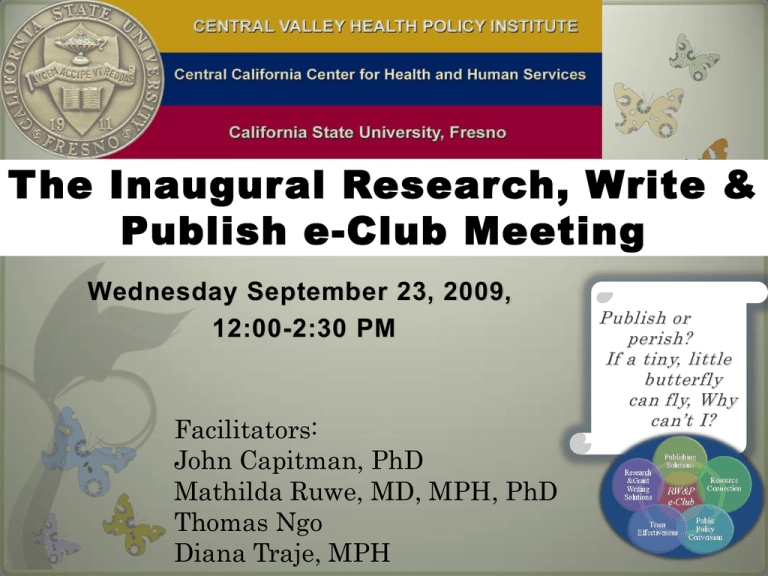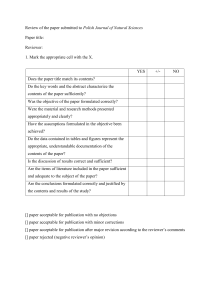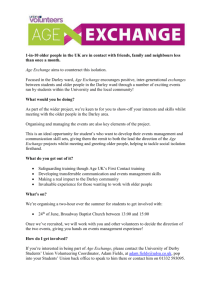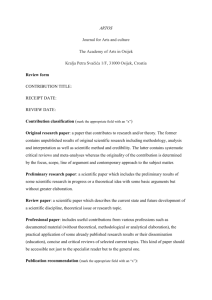The Inaugural Research, Write & Publish e-Club Meeting Wednesday September 23, 2009,
advertisement

The Inaugural Research, Write & Publish e-Club Meeting Wednesday September 23, 2009, 12:00-2:30 PM Facilitators: John Capitman, PhD Mathilda Ruwe, MD, MPH, PhD Thomas Ngo Diana Traje, MPH Publish or perish? If a tiny, little butterfly can fly, Why can’t I? Meeting Agenda Time Subject Presenter/Facilitator 12:00-12:05 Background and welcome remarks Get Lunch 12:05-12:15 12:15-12:30 Self-introduction Speed network: teaching interest; writing interests, research interests, hobbies (spend five minutes in each and switch pairs every five minutes Key note speech Road Map to Tenure and Promotion: Role of Publication and Research Introduction to RW&P e-club collaboration tools, including introduction of club positions Dr. John Capitman Director Central Valley Health Policy Institute All All (Dr Mathilda Ruwe, facilitator) 12:30-12:45 12:45-1:15 1:15-1:30 1:30-1:45 1:45-2:15 2:15-2:30 Needs assessment feedback plus Q&A session Overview of writing for publication Breakout session: working in groups of two or three to discuss writing goal, generate individualized or group writing goals Plenary and closing remarks(appreciations, regrets, suggestions for next meeting) Dr. Andrew Hoff Dean College of Health And Human Services Dr Ruwe and Thomas Ngo Dr. Ruwe Dr Capitman Drs. Ruwe/Capitman All SPEED NETWORKING Break in pairs Discuss with your colleague the writing project you wished you could get done or you can’t seem to get started Each person gets about two minutes to share, then switch partners KEY NOTE SPEECH Road Map to Tenure and Promotion: Role of Publication and Research Dr Andrew Hoff Dean of the College of Health and Human Services California State University, Fresno INTRODUCTION TO RW&P eCLUB COLLABORATION TOOLS The RW&P e-Club Mission Provide a forum for faculty to collaborate on research and publishing Approach Mainly through electronic collaboration with occasional in-person meetings Participation Free participation Open to in Faculty and research staff in CSU Fresno Colleges and Foundation, Institutes RW&P e-Club •Objectives •Increase faculty and staff whose research work becomes published •Increase faculty and staff participation in funded research •Generate faculty interest in discourse around policy issues relevant the Central Valley •Increase opportunities for tenure relevant faculty development activities RW&P e-Club Tour •Purpose of the electronic collaboration suite •Facilitate on going networking between members •Serve as a problem solving •Serve as a resource base •Serve as continuing education forum forum RW&P e-Club Tour •Main • features of the e-club Announcements •Club information •Contact us •Discussion Board http://blackboard.csufresno.edu/ RW&P e-Club Tour •E-club • Tour highlights Club information •Discussion Board Club Information This is the e-club home page Contains information about the club and links to resources Resource links highlights Funding sources Federal grants Proposal central (federal and foundation grants) Cabell’s directories—advice on journal publishing Text Academic Authoring association (TAA) Club Information-Additional functions Open What for discussion -- other functions or resources would you like to see in the-club information forum? Discussion Board This is the main e-club collaboration tool Discussion board highlights Asking questions Suggesting discussion topics Also exploring other capabilities e-g co-editing, web seminars Discussion board challenges Open for discussion What would be your motivation for visiting discussion board regularly? What other mechanisms can we use to prompt members to a new discussion topic that minimize e-mail flooding? FACULTY AND STAFF CLUB POSITIONS Co-chair 1 position Club secretary : 1 position Planning team member -4 positions All positions are voluntary Please indicate your interest in any of the listed positions by entering your name under the provided space Names will be entered in a random draw at the end of this meeting NEEDS ASSESSMENT FEEDBACK PLUS Q&A SESSION OVERVIEW OF WRITING A JOURNAL ARTICLE A Bird’s EyeView Dr John Capitman Overview on Writing for Publication Questions explored Who can be a journal article author? What are the common journal articles? What type of article should you write? Where does the information come from? Where do you start as a novel author? Now that you have collected and analyzed the data, what story should you tell? How do you maximize your chances for your manuscript to be accepted for publication? What are the advantages of having more than one author on a paper? What are the main issues in collaborative authorships? What are the main issues in multi-disciplinary authorships? What are the benefits of being an academic author? How do you respond to a Journal editor’s feedback Who can be a journal article author? Any one with data, knowledge of the field they are writing in and a story to tell can write a journal article What are the common journal articles? Secondary research articles Review articles Systematic review and metaanalysis Primary research studies Theory and concept papers What type of article should you write? Choice of article type is driven by: The type of study that produced the data The publication goals and audience you are trying to reach Your skill in interpreting and presenting the data in the format demanded by the publication type and discipline you are writing in Where do you start as a novel author? A novel author has a number of choices Join an establish team and contribute to any process of the study and be a co-author Publish part(s) of your dissertation Publish a term paper that you think has new information to contribute Conduct a literature review or systematic review on a subject that has not been resolved Now that you have collected and analyzed your data, what story should you tell? Two basic approaches Write the story you originally intended when you designed the study Write the story that has emerged after analyzing the data In both cases Be sure you have evidence in your data to back up your conclusions Identify the major contribution you are making What are the main issues in collaborative authorships? Determine team leader Determine authorship order Three approaches Alphabetical order By level of contribution to substantive knowledge By career advancement objectives? What are the main issues in multi-disciplinary authorships? Differences in research language across disciplines Determining Finding publication audience the right reviewer? What are the advantages of having more than one author on a paper? Collective Sharing credibility of writing responsibilities How do you maximize your chances for your manuscript to be accepted for publication? Give the Journal what it wants CSSS—Clarity, Style, Science and Story Understand the type of studies published by the journal—see examples from previous studies Understand the style format required by the Journal—follow guidelines provided by the journal Be clear on what your article is contributing to the advancement of existing knowledge Communicate potential applications of your research findings Address study limitation s How do you react to editor’s feedback? You will get three types of feedback Provisionally accepted pending revisions in accord to reviewers comments Rejected but invited to resubmit a revised version Rejected Darley et al., 2004 How do you address editor ’s feedback EDITOR’S FEEDBACK AUTHOR’S ACTION Provisionally accepted pending revisions in accord to reviewers comment Rejected but invited to resubmit a revised version Be happy and address reviewers comments Rejected due to substantial flaws or poor fit for the Journal Do not stress over it Ask for reviewers comments, address comments and submit to a different journal Darley et al., 2004 Be happy, address reviewer’s comments and resubmit Responding to reviewer ’s comments Pay attention to criticism or suggestions made by more than one reviewer Look carefully at each reviewer’s misreading if any Analyze reasons for misreading and re-write problematic sections Include a cover letter in your revised manuscript Include explanation of how you addressed each reviewer’s comment Source: Darley et al 2004 How do you respond to reviewer ’s comments? There are right and wrong ways to respond to reviewer’s comments See examples from Darley et al, 2004 Page 218-219 Source: Darley et al 2004 Responding to reviewer ’s comments Exhibit 1 Darley et al., 2004, page 218 Responding to Reviewer ’s Comments-exhibit 2 Darley et al., 2004, page 218 Responding to Reviewers Comments-exhibit 3 Darley et al., 2004, page 219 What are the responsibilities and benefits of academic authoring? Responsibilities Accuracy Objectivity Ethical conduct of research Contribution to solving real life problems Benefits Establishing your leadership in advancing knowledge in your field of study Being an authoritative voice in your area of expertise Tenure and promotion credits WRITING GOALS AND, INDIVIDUALIZED OR GROUP WRITING WORK PLANS •Break up in groups of three •Share with your colleagues a writing or research idea you would like to do as a club project •Use the provided worksheet to write down your goals and draft work plan Recommend Further Reading Darley JM, Zanna, MP and Roediger III, HL. (2004). Tara Gray. (2005) Publish and Flourish: Become a prolific Scholar. Teaching Academy Strunk Jr. , W. and White EB (2000). The Elements of Style . Fourth edition. Longman Feibelman PJ (1993). A Ph.D is Not Enough. A Guide to The Complete Academic: A Career guide. Second edition. The American Psychology Association survival in Science. Addison Wesley Publishing Company PLENARY AND CLOSING REMARKS •Appreciations, regrets •Suggestions for next meeting •Closing remarks—Dr capitman


